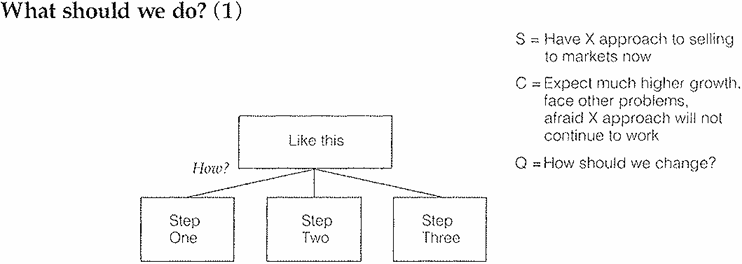


 Grammar
Grammar
 Tenses
Tenses
 Present
Present
 Past
Past
 Future
Future
 Parts Of Speech
Parts Of Speech
 Nouns
Nouns
 Verbs
Verbs
 Adverbs
Adverbs
 Adjectives
Adjectives
 Pronouns
Pronouns
 Pre Position
Pre Position
 Preposition by function
Preposition by function 
 Preposition by construction
Preposition by construction
 Conjunctions
Conjunctions
 Interjections
Interjections
 Grammar Rules
Grammar Rules
 Linguistics
Linguistics
 Semantics
Semantics
 Pragmatics
Pragmatics
 Reading Comprehension
Reading Comprehension|
Read More
Date: 2024-09-09
Date: 2024-09-09
Date: 2024-09-13
|
As you have seen, the Problem Definition Framework for the most part lays out the problem elements in the order in which they can most easily be used in the introduction. You simply move from left to right and down. The last thing known by the reader is always the Complication.
Following are examples illustrating the introduction and pyramid for each of the seven standard questions. These examples are somewhat abstract, in order to emphasize the bare structure, but you can read the full content of each introduction in Appendix B, Examples of Introductory Structures.

This structure is the simplest of all to analyze and write, since the Situation always describes what is going on now, and the Complication is always that the reader is at R1 and wishes to be at R2. This is also the structure used to tell someone how to change or upgrade a system that is presently in operation. In that case, you would have:
Situation Here's how the system works today
Complication It does not do what it is meant to do
Question How do we make it do what it is meant to do?
The plural noun for the Key Line here would be "changes." It differs slightly from the structure you would use if you were telling someone how to do something new, where the plural noun would be "steps."
Situation Here's the activity we are trying to perform
Complication We are not able to perform it
Question How do we create the capability to perform it?
|
|
|
|
تفوقت في الاختبار على الجميع.. فاكهة "خارقة" في عالم التغذية
|
|
|
|
|
|
|
أمين عام أوبك: النفط الخام والغاز الطبيعي "هبة من الله"
|
|
|
|
|
|
|
قسم شؤون المعارف ينظم دورة عن آليات عمل الفهارس الفنية للموسوعات والكتب لملاكاته
|
|
|